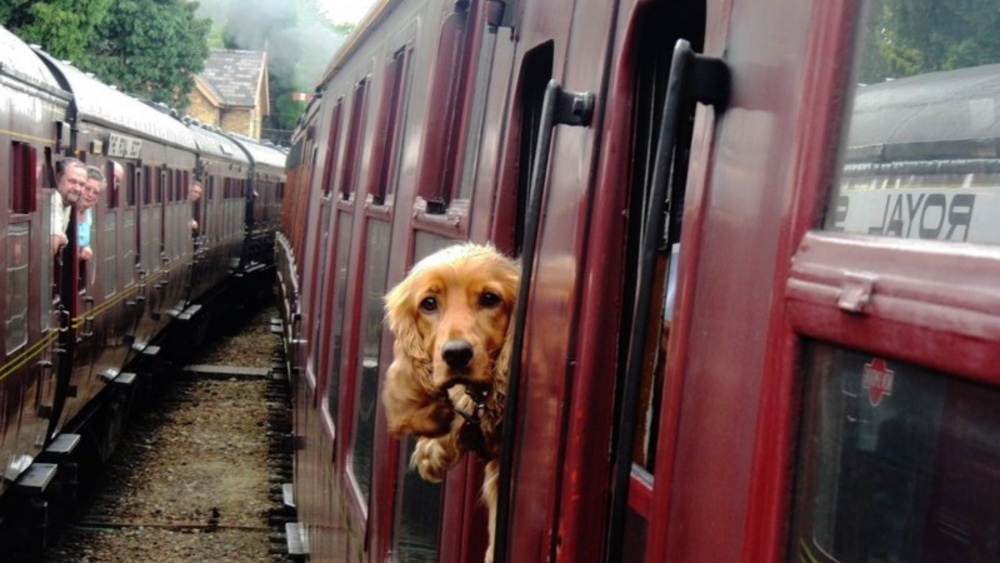
Trains are a cost-effective and convenient way to travel in most countries, but when your dog comes with you, it can make planning your journey a little bit more complicated.
So, can dogs travel on trains? There are railways that are happy to let your dog travel with you, while others will have strict guidelines as to what breed of dogs are allowed, a dog’s role in a passenger’s life, even down to their size and weight.
Here are some guidelines for travelling with your dog in different areas around the world.
Assistance Animals
If your dog is a legally certified assistance animal, then it can travel much more freely with you on almost any railway. Restrictions regarding dogs on trains are almost always only referring to pet dogs. If you do travel with your assistance animal, make sure you have any relevant documentation and any visible markers for your dog (such as a guide dog vest or similar) in case their status as an assistance animal is questioned.
Europe
Major railways Rail Europe and RailJet allow dogs to travel with them – in fact, most trains in Europe will allow you to take your dog. Only service dogs for visually impaired passengers are allowed on Eurostar trains.
Dogs that cross country borders should have an EU pet passport issued by a veterinarian, and will need to be microchipped and up-to-date with rabies vaccinations.
There are many major railways that will carry your dog in Europe. Please note that these are only some of the basic conditions for travel, and you should look up the restrictions for your particular route and time of travel. Some dog-friendly European railways are:
- Virgin Trains – two dogs on the east and west coast routes, at no extra cost.
- TYG Lyria – dogs less than 6 kgs can travel in a basket. Dogs heavier than 6 kg will need a pet fare and to wear a muzzle.
- Thello – Pets less than 5 kg can travel with no reservation and no fee. Over 5 kg, and they must travel in a cabin and not be left alone.
- Thalys – Small dogs can travel in a carrier without a fee. Larger dogs should be leashed and muzzled, and need to pay a dog fare.
- Deutche Bahn – Dogs need to pay a half-fare if they cannot fit into a carrier, otherwise they can travel free domestically.
- Renfe – One pet under 10 kgs can travel free.
- SNCF – Book your dog’s ticket with your own. Small dogs must travel in a carrier, larger dogs should be muzzled.
- OBB – Small dogs are free in a carrier. Larger dogs pay a fee and must be on a leash and a muzzle.
- Trenatilia – Small dogs can travel free in first and second class. Regional trains have time restrictions for traveling with dogs.
- ScotRail – if you book ahead and pay an extra cleaning fee, your dog can accompany you.
The U.K.
On the National Rail in the U.K., your dog is welcome to travel with you as long as you meet their requirements. Customers can take with them a maximum of two animals free of charge, providing they:
- Don’t endanger or inconvenience customers or staff
- Keep their dogs on a leash or in an enclosed, comfortable basket
- Do not let their dog occupy a seat – otherwise, the passenger will be charged for the seat
- Do not enter into restaurant cars with their dog (on sleeper services)
- Pay an extra cleaning fee on the Caledonian Sleeper
All bookings for dogs travelling in Sleeper services need to be made at least 48 hours in advance, and they can only be booked into single-occupant accommodation.
Bear in mind that the law allows the train company to refuse entry to any animal for any reason (except service animals). If your dog is causing any problems, you may be asked to leave. If another customer objects to your dog, you must move it to another part of the train or put it in the guard or luggage van.
Australia:
If you want to travel by train with your dog in Australia, it will depend largely on where you want to go. In New South Wales, for example, your dog is not allowed to travel with you on the train, but could be allowed with you on a bus if it is contained in a basket. In Melbourne, dogs are allowed on trains if they are on a lead and muzzled, or in a crate.
Each state has its own regulations, and they can even be different between urban routes and regional areas. You might find you can get on a train but not onto any connecting services. If you want to take your dog on the train in Australia, you should plan ahead for your specific journey.
U.S.A.
The U.S.A. has many different railways all with their own regulations, and you will need to do specific research into your journey to find out if that particular train will allow dogs or not. If you have a small dog that can fit in a carrier, your chances of being able to travel by train with your pet are much higher.
Major U.S. railway Amtrack changed their rules a few years ago to allow travellers to bring small dogs on some routes for a fee, so there is a good chance your dog will be able to accompany you.
India
Dogs can travel with you on some Indian trains, but you will need to book a two-berth, first class compartment to be sure that your dog will be able to stay with you. You will then pay a luggage charge that is based on the weight of the dog. If you do not secure first class seating or another passenger objects, your dog may have to travel in a cage in the brake van, which could be unpleasant.
Train Travels with your Pooch
These are just a very few examples of train companies that will allow your dog to travel, but of course there are many more.
There are a few common themes for train travel with your dog. If you have a small dog, they are more likely to be welcome and will need to be in a carrier. If you have a larger dog and they are allowed on the train, they will need to be leashed and on many services, also muzzled.
Make sure that you have your pet’s papers including vaccination status, and it’s a good idea to book at least 48 hours ahead for most railway services. Remember that if your dog is causing any issues or other passengers just don’t want to travel with a dog, you could be asked to leave.
If your dog is not happy to travel, it might be best if other arrangements are made so they can stay at home. However, if they do well in exciting environments, travelling with your dog can be an extremely rewarding experience.
Make sure you do your research on the requirements for having your dog with you, remember to put your pet’s wellbeing first on your list of priorities and – enjoy your train trip!
